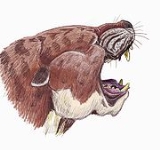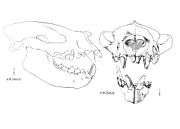
Sarkastodon
Encyclopedia
Sarkastodon is an extinct genus
within the family
Oxyaenidae
that lived during the upper Eocene
, approximately 35 million years ago. It was a large, carnivorous animal that lived in what is today Mongolia
. It is estimated to have been about 800 kilograms in weight, somewhat bigger than any living bear in average body size and near the maximum possible size for terrestrial carnivorous mammals. It is seen today in animals such as the Kodiak bear
, which reaches that size only in captivity. Sarkastodon is assumed to have had a bear-like appearance, though only skulls and jawbones are known. Sarkastodon, like Creodonts in general, was probably a hypercarnivore that preyed on large mammals in its range during the Late Eocene, such as brontotheres, chalicothere
s, and rhinoceroses.
specimens of S. mongoliensis are known from Eocene deposits from the Irdin Manha Formation of Mongolia
. Additional material referred to Sarkastodon is known from the Ulan Shireb beds (100 miles away from the holotype locality) of Inner Mongolia. These specimens were discovered by Dr. Garber in 1930, on an expedition to the Gobi Desert
.
, with hyaena
-like dentition specialised in bone-cracking. The sharp, slicing premolar
s (which form roughly rectilinear cutting blades) and crushing molar
s enabled Sarkastodon to eat both bone and flesh.

Genus
In biology, a genus is a low-level taxonomic rank used in the biological classification of living and fossil organisms, which is an example of definition by genus and differentia...
within the family
Family (biology)
In biological classification, family is* a taxonomic rank. Other well-known ranks are life, domain, kingdom, phylum, class, order, genus, and species, with family fitting between order and genus. As for the other well-known ranks, there is the option of an immediately lower rank, indicated by the...
Oxyaenidae
Oxyaenidae
Oxyaenidae is a family of the extinct order Creodonta; it contains three subfamilies comprising ten genera. The placement of a fourth subfamily, Machaeroidinae, is unsure; it may belong here or in Hyaenodontidae....
that lived during the upper Eocene
Eocene
The Eocene Epoch, lasting from about 56 to 34 million years ago , is a major division of the geologic timescale and the second epoch of the Paleogene Period in the Cenozoic Era. The Eocene spans the time from the end of the Palaeocene Epoch to the beginning of the Oligocene Epoch. The start of the...
, approximately 35 million years ago. It was a large, carnivorous animal that lived in what is today Mongolia
Mongolia
Mongolia is a landlocked country in East and Central Asia. It is bordered by Russia to the north and China to the south, east and west. Although Mongolia does not share a border with Kazakhstan, its western-most point is only from Kazakhstan's eastern tip. Ulan Bator, the capital and largest...
. It is estimated to have been about 800 kilograms in weight, somewhat bigger than any living bear in average body size and near the maximum possible size for terrestrial carnivorous mammals. It is seen today in animals such as the Kodiak bear
Kodiak Bear
The Kodiak bear , also known as the Kodiak brown bear or the Alaskan grizzly bear or American brown bear, occupies the islands of the Kodiak Archipelago in South-Western Alaska. Its name in the Alutiiq language is Taquka-aq. It is the largest subspecies of brown bear.- Taxonomy :Taxonomist C.H...
, which reaches that size only in captivity. Sarkastodon is assumed to have had a bear-like appearance, though only skulls and jawbones are known. Sarkastodon, like Creodonts in general, was probably a hypercarnivore that preyed on large mammals in its range during the Late Eocene, such as brontotheres, chalicothere
Chalicothere
Chalicotheres were a group of herbivorous, odd-toed ungulate mammals spread throughout North America, Europe, Asia, and Africa during the Early Eocene to Early Pleistocene subepochs living from 55.8 mya—781,000 years ago, existing for approximately .They evolved around 40 million years ago from...
s, and rhinoceroses.
Discovery
The typeBiological type
In biology, a type is one particular specimen of an organism to which the scientific name of that organism is formally attached...
specimens of S. mongoliensis are known from Eocene deposits from the Irdin Manha Formation of Mongolia
Mongolia
Mongolia is a landlocked country in East and Central Asia. It is bordered by Russia to the north and China to the south, east and west. Although Mongolia does not share a border with Kazakhstan, its western-most point is only from Kazakhstan's eastern tip. Ulan Bator, the capital and largest...
. Additional material referred to Sarkastodon is known from the Ulan Shireb beds (100 miles away from the holotype locality) of Inner Mongolia. These specimens were discovered by Dr. Garber in 1930, on an expedition to the Gobi Desert
Gobi Desert
The Gobi is a large desert region in Asia. It covers parts of northern and northwestern China, and of southern Mongolia. The desert basins of the Gobi are bounded by the Altai Mountains and the grasslands and steppes of Mongolia on the north, by the Hexi Corridor and Tibetan Plateau to the...
.
Palaeobiology
Sarkastodon was a hypercarnivoreHypercarnivore
A hypercarnivore is an animal which has a diet that is more than 70% meat, with the balance consisting of non-animal foods such as fungi, fruits or other plant material. Some examples include the big cats, dolphins, eagles, snakes, marlin, most sharks, and such invertebrates as octopuses and sea...
, with hyaena
Hyaena
For the Siouxsie and the Banshees album, see Hyæna.For the group of animals commonly known as "hyaena", see Hyena.Hyaena is a genus comprising two of the living species of hyenas: the striped hyena from western Asia and northern Africa and the brown hyena from southern Africa...
-like dentition specialised in bone-cracking. The sharp, slicing premolar
Premolar
The premolar teeth or bicuspids are transitional teeth located between the canine and molar teeth. In humans, there are two premolars per quadrant, making eight premolars total in the mouth. They have at least two cusps. Premolars can be considered as a 'transitional tooth' during chewing, or...
s (which form roughly rectilinear cutting blades) and crushing molar
Molar
Molar may refer to:*Molar , the fourth kind of tooth in mammals*Molar , another name for the Spanish wine grape Listan Negro*Molar concentration, a unit of concentration, or molarity, of solutions equal to 1 mole per litre*Molar volume...
s enabled Sarkastodon to eat both bone and flesh.

External links
- PDF of Granger, 1938
- Artistic reconstruction of Sarkastodon, shown waiting for Andrewsarchus to finish eating from a dead brontothere.

